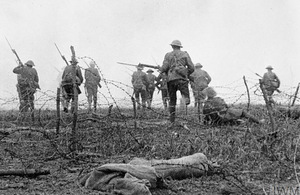Reflections on the Somme
As the nation marks the 100th anniversary of the Battle of the Somme, what really happened in those 141 days?

Battle of the Somme (Credit: IWM)
One hundred years ago today, one of the bloodiest episodes of the First World War ended as the Somme offensive was abandoned.
Prior to the start of the battle on 1 July 1916, and after months of preparations, the Allied expectation had been of a swift breakthrough, and potentially even the defeat of the German Army on the Western Front. But the attack on the first day was a disaster, with 60,000 British casualties including nearly 20,000 dead. The Allied troops had suffered heavy losses by both machine gun and artillery fire as the Germans emerged from deep dug-outs to defend their positions during the prolonged artillery barrage in the weeks preceding the battle. Many attacks faltered on German barbed wire and reinforcements suffered heavily as German artillery concentrated their fire on the British trenches. Over the following 141 days, the Allies continued to struggle gaining just six miles of territory. Many attacks were launched, often with mixed results and little progress overall. Infantry pressed forward, but ultimately foundered and were unable to seize their objectives. Where surprise could be achieved the results were often successful, but the Allies were never able to exploit local successes.
Technical innovations were also used which surprised the German defenders. On 15 September tanks were used for the first time, but there were insufficient numbers, they were mechanically unreliable, and the tactics were untested. The attack caused initial surprise but this fell away and breakthrough was not achieved.
Despite setbacks Allied tactics continued to develop with ever closer cooperation between infantry, artillery, tanks and the Royal Flying Corps, but German resistance continued to defy all Allied attempts to break through.
Having lost most of the army’s pre-war regular soldiers in the battles of 1914 and 1915, the bulk of the Army was now made up of volunteers of the Territorial Force and Lord Kitchener’s New Army which had been forming since August 1914. The vastly expanded armies on both sides lacked experience at every level of command and both had the weapons to make any attack on trench lines and heavily fortified positions very costly. Mounting an offensive meant months of preparation (building roads, railways, camps and water supplies) but such efforts meant surprise was difficult and the problems of exploiting success proved insurmountable. The British had fielded new technology and achieved limited success, but not on the scale needed.
By the time the offensive was finally called off on 18 November, the Allies had lost around 620,000 men and the Germans 450,000. Allied success was limited; the British ‘Kitchener’ Army had developed as a fighting force, Commonwealth forces had distinguished themselves, the front line had advanced some six miles on a twelve mile front, and the Germans had been forced to divert troops away from Verdun. But no breakthrough had been achieved, the German fighting spirit had not been broken, and they too had learnt lessons.